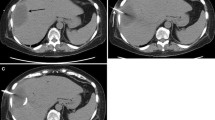Abstract
The purpose of this study was to assess whether regular instillation of urokinase during abscess drainage leads to an improved outcome compared to saline irrigation alone. One hundred patients referred for image-guided abdominal abscess drainage were randomized between thrice daily urokinase instillation or saline irrigation alone. At the end of the study, patient medical records were reviewed to determine drainage, study group, Altona (PIA II) and Mannheim (MPI) scoring, duration of drainage, procedure-related complications, hospital stay duration, and clinical outcome. The technical success rate of the percutaneous abscess drainage was 100%. The success or failure of abscess remission did not differ significantly between groups (success rate of 91.5% in the urokinase group vs. 88.8% in the saline group; failure rate was of 8.5 vs. 21.2%, respectively); however, days of drainage, main hospital stay, and overall costs were significantly reduced in patients treated with urokinase compared to the control group (P < 0.05). No adverse effects from urokinase were observed. Surgical scores were a useful homogeneity factor, and MPI showed a good correlation with prognosis, while PIA results did not have a significant correlation. For drainage of complex abscesses (loculations, hemorrhage, viscous material), fibrinolytics safely accelerate drainage and recovery, reducing the length of the hospital stay and, therefore, the total cost.



Similar content being viewed by others
References
Men S, Akha O, Koroglu M (2002) Percutaneous drainage of abdominal abscess. Eur J Radiol 43:204–218
Goletti O, Lippolis PV, Chiarugi M et al (1993) Percutaneous ultrasound-guided drainage of intra-abdominal abscesses. Br J Surg 80:336–339
Betsch A, Wiskirchen J, Trübenbach J et al (2002) CT-guided percutaneous drainage of intra-abdominal abscses. APACHE III score stratification of 1 year results. Eur Radiol 12:2883–2880
VanSonnenberg E, Wittich GR, Goodacre BW, Casola G et al (2001) Percutaneous abscess drainage update. World J Surg 25:362–369
Haaga JR, Weinstein AJ (1980) CT-guided percutaneous aspiration and drainage of abscesses. Am J Roentgenol 135:1187–1194
Van Sonnenberg E, Wittich GR, Goodacre BW et al (2001) Percutaneous abscess drainage: update. World J Surg 25:362–369
Gerzof S, Robbins A, Johnson W et al (1981) Percutaneous catheter drainage of abdominal abscesses: a 5-year experience. N Engl J Med 305:653–657
Mc Fadzean A, Chang K, Wong C (1953) Solitary pyogenic abscess of the liver treated by closed aspiration and antibiotic: a report of 14 consecutive cases with recovery. Br J Surg 41:141–152
VanSonnenberg E, D’Agostino HB, Casola G et al (1991) US-guided transvaginal drainage of pelvic abscesses and fluid collections. Radiology 181:53–56
Gervais DA, Brown SD, Connolly SA et al (2004) Percutaneous imaging-guided abdominal and pelvic abscess drainage in children. Radiographics 24:737–754
Maher MM, Gervais DA, Kalra MK et al (2004) The inaccessible or undrainable abscess: how to drain it. Radiographics 24:717–735
Haaga JR, Nakamoto D, Stellato T et al (2000) Intracavitary urokinase for enhancement of percutaneous abscess drainage: phase II trial. AJR 174:1681–1685
Park JK, Graus FC, Haaga JR (1993) Fluid flouw during percutaneus drainage procedures: an in vitro study of the effects of fluid viscosity, catheter size and adjunctive urokinase. AJR 160:165–169
Keeling AN, Leong S, Logan PM et al (2008) Empyema and effusion: outcome of image-guided small-bore catheter drainage. Cardiovasc Intervent Radiol 31:135–141
Temes RT, Follis F, Kessler RM et al (1996) Intrapleural fibrinolytics in management of thoracic empyema. Chest 110:102–106
de Gregorio MA, Miguelena JM, Medrano J (2005) Abdominal abscess drainage. Advantages of fibrinolytic agents. Cir Esp 77(6):315–320
Lahorra JM, Haaga JR, Stellato T et al (1993) Safety of intracavitary urokinase with percutaneous abscess drainage. AJR 160:171–175
Ohmann C, Wittmann DH, Wacha H (1993) Prospective evaluation of prognostic scoring systems in peritonitis. Peritonitis Study Group. Eur J Surg 159(5):267–274
Kologlu M, Elker D, Altun H et al (2001) Validation of MPI and PIA II in two different groups of patients with secondary peritonitis. Hepatogastroenterology 48:147–151
Ohmann C, Hau T (1997) Prognostic indices in peritonitis. Hepatogastroenterology 44:937–946
Kologlu M, Elker D, Altun H et al (2001) Validation of MPI and PIA II in two different groups of patients with secondary peritonitis. Hepatogastroenterology 48:147–151
Horiuchi A, Watanabe Y, Doi T et al (2007) Evaluation of prognostic factors and scoring system in colonic perforation. World J Gastroenterol 13(23):3228–3231
Kumar R, Kim J, Haukoos J et al (2006) Factors affecting the successful management of intra-abdominal abscess with antibiotcs and need for percutaneous drainage. Dis Colon Rectum 49:183–189
Cinat M, Wilson S, Din A (2002) Determinants for successful percutaneous image guided drainage of intraabdominal abscess. Arch Surg 137:845–849
Le Gall J, Lemeshow S, Saulnier F (1993) A new simplified acute Phisiology score (SAPS II) on a European/North American multicenter study. JAMA 270:2957–2963
Vogelzang RL, Tobin RS, Burstein S et al (1987) Transcatheter intracavitary fibrinolysis of infected extravascular hematomas. AJR Am J Roentgenol 148:378–380
Tillett WS, Sherry S, Read CT (1951) The use of streptokinase-streptodomase in the treatment of chronic emphyema. J Thorac Surg 21:325–341
Bergh NP, Ekroth R, Larson S et al (1977) Intrapleural streptokinase in the treatment of haemothorax and empyema. Scand J Thorac Cardiovasc Surg 11:265–268
Berglin W-O, Ekroth R, Teger-Nilsson AC et al (1981) Intrapleural instillation of streptokinase effects on systemic fibrinolysis. Thorac Cardiovasc Surg 29:124–126
Hau T, Simmons RL (1976) Anticoagulation in the treatment of experimental peritonitis. Surg Forum 27:458–460
Nakamoto DA, Haaga JR, Bove P, Merritt K, Rowland DY (1995) Use of fibrinolytic agents to coat wire im-plants to decrease infection: an animal model. Invest Radiol 30:341–344
De Gregorio MA, Ruiz C, Alfonso ER et al (1999) Transcatheter intracavitary fibrinolysis of loculated pleural effusions: experience in 102 patients. Cardiovasc Intervent Radiol 22(2):114–118
Moulton JS, Moore PT, Mencini RA (1989) Treatment of loculated pleural effusions with transcatheter intracavitary urokinase. AJR 153:941–945
Author information
Authors and Affiliations
Corresponding author
Rights and permissions
About this article
Cite this article
Laborda, A., De Gregorio, M.A., Miguelena, J.M. et al. Percutaneous treatment of intrabdominal abscess: urokinase versus saline serum in 100 cases using two surgical scoring systems in a randomized trial. Eur Radiol 19, 1772–1779 (2009). https://doi.org/10.1007/s00330-009-1311-z
Received:
Revised:
Accepted:
Published:
Issue Date:
DOI: https://doi.org/10.1007/s00330-009-1311-z




